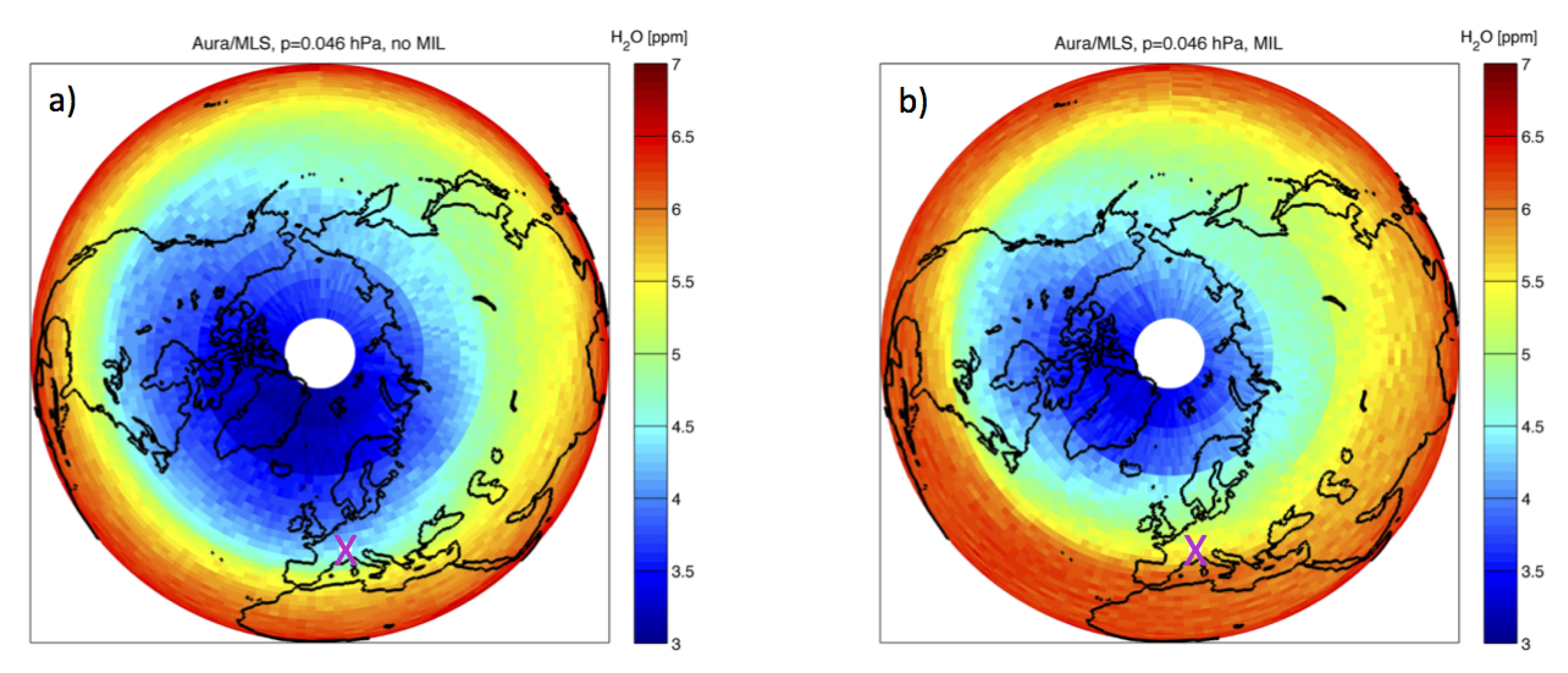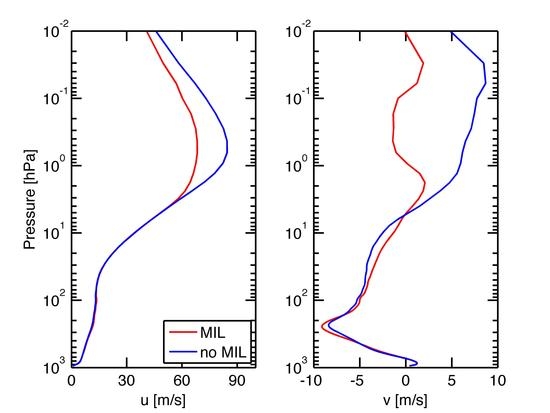Mesospheric Inversion Layers at Mid-Latitudes and Coincident Changes of Ozone, Water Vapour and Horizontal Wind in the Middle Atmosphere
Abstract
:1. Introduction
2. Data Sets
2.1. The Aura Microwave Limb Sounder
2.2. ECMWF Operational Analysis
2.3. The Ozone Microwave Radiometer GROMOS
2.4. The Middle Atmospheric Water Radiometer MIAWARA
3. Results
3.1. Mesospheric Inversion Layer above Bern
3.2. Coincident Changes in Horizontal Wind above Bern
3.3. Coincident Changes in Ozone and Water Vapour above Bern
3.4. Northern Hemispheric Changes in Mesospheric Water Vapour and Temperature
4. Conclusions
Author Contributions
Acknowledgments
Conflicts of Interest
References
- Meriwether, J.W.; Gerrard, A.J. Mesosphere inversion layers and stratosphere temperature enhancements. Rev. Geophys. 2004, 42. [Google Scholar] [CrossRef]
- France, J.A.; Harvey, V.L.; Randall, C.E.; Collins, R.L.; Smith, A.K.; Peck, E.D.; Fang, X. A climatology of planetary wave-driven mesospheric inversion layers in the extratropical winter. J. Geophys. Res. Atmos. 2015, 120, 399–413. [Google Scholar] [CrossRef]
- Sassi, F.; Garcia, R.R.; Boville, B.A.; Liu, H. On temperature inversions and the mesospheric surf zone. J. Geophys. Res. Atmos. 2002, 107. [Google Scholar] [CrossRef]
- Salby, M.; Sassi, F.; Callaghan, P.; Wu, D.; Keckhut, P.; Hauchecorne, A. Mesospheric inversions and their relationship to planetary wave structure. J. Geophys. Res. Atmos. 2002, 107. [Google Scholar] [CrossRef]
- Gan, Q.; Zhang, S.D.; Yi, F. TIMED/SABER observations of lower mesospheric inversion layers at low and middle latitudes. J. Geophys. Res. Atmos. 2012, 117, D07109. [Google Scholar] [CrossRef]
- Schmidlin, F.J. Temperature inversions near 75 km. Geophys. Res. Lett. 1976, 3, 173–176. [Google Scholar] [CrossRef]
- Hauchecorne, A.; Chanin, M.L.; Wilson, R. Mesospheric temperature inversion and gravity wave breaking. Geophys. Res. Lett. 1987, 14, 933–936. [Google Scholar] [CrossRef]
- Leblanc, T.; Hauchecorne, A. Recent observations of mesospheric temperature inversions. J. Geophys. Res. Atmos. 1997, 102, 19471–19482. [Google Scholar] [CrossRef]
- Irving, B.K.; Collins, R.L.; Lieberman, R.S.; Thurairajah, B.; Mizutani, K. Mesospheric Inversion Layers at Chatanika, Alaska (65 N, 147 W): Rayleigh lidar observations and analysis. J. Geophys. Res. Atmos. 2014, 119, 11235–11249. [Google Scholar] [CrossRef]
- Liu, H.L.; Meriwether, J.W. Analysis of a temperature inversion event in the lower mesosphere. J. Geophys. Res. Atmos. 2004, 109. [Google Scholar] [CrossRef]
- Liu, H.L.; Hagan, M.E.; Roble, R.G. Local mean state changes due to gravity wave breaking modulated by the diurnal tide. J. Geophys. Res. Atmos. 2000, 105, 12381–12396. [Google Scholar] [CrossRef]
- Waters, J.W.; Froidevaux, L.; Harwood, R.S.; Jarnot, R.F.; Pickett, H.M.; Read, W.G.; Siegel, P.H.; Cofield, R.E.; Filipiak, M.J.; Flower, D.A.; et al. The Earth Observing System Microwave Limb Sounder (EOS MLS) on the Aura satellite. IEEE Trans. Geosci. Remote Sens. 2006, 44, 1075–1092. [Google Scholar] [CrossRef]
- Schwartz, M.J.; Lambert, A.; Manney, G.L.; Read, W.G.; Livesey, N.J.; Froidevaux, L.; Ao, C.O.; Bernath, P.F.; Boone, C.D.; Cofield, R.E.; et al. Validation of the Aura Microwave Limb Sounder temperature and geopotential height measurements. J. Geophys. Res. Atmos. 2008, 113. [Google Scholar] [CrossRef] [Green Version]
- Livesey, N.J.; Read, W.G.; Wagner, P.A.; Froidevaux, L.; Lambert, A.; Manney, G.L.; Millan Valle, L.F.; Pumphrey, H.C.; Santee, M.L.; Schwartz, M.J.; et al. Earth Observing System (EOS), Aura Microwave Limb Sounder (MLS), Version 4.2x Level 2 Data Quality and Description Document; Rep. JPL D-33509 Rev. C.; Jet Propulsion Laboratory: Pasadena, CA, USA, 2017.
- ECMWF Model. Available online: https://www.ecmwf.int/en/research/modelling-and-prediction (accessed on 1 May 2018).
- Dragani, R.; McNally, A.P. Operational assimilation of ozone-sensitive infrared radiances at ECMWF. Q. J. R. Meteorol. Soc. 2013, 139, 2068–2080. [Google Scholar] [CrossRef]
- Rüfenacht, R.; Murk, A.; Kämpfer, N.; Eriksson, P.; Buehler, S.A. Middle-atmospheric zonal and meridional wind profiles from polar, tropical and midlatitudes with the ground-based microwave Doppler wind radiometer WIRA. Atmos. Meas. Tech. 2014, 7, 4491–4505. [Google Scholar] [CrossRef] [Green Version]
- Eriksson, P.; Jimenez, C.; Buehler, S.A. Qpack, a general tool for instrument simulation and retrieval work. J. Quant. Spectrosc. Radiat. Transf. 2005, 91, 47–64. [Google Scholar] [CrossRef]
- Eriksson, P.; Buehler, S.A.; Davis, C.P.; Emde, C.; Lemke, O. ARTS, the atmospheric radiative transfer simulator, version 2. J. Quant. Spectrosc. Radiat. Transf. 2011, 112, 1551–1558. [Google Scholar] [CrossRef]
- Rodgers, C.D. Inverse Methods for Atmospheric Sounding—Theory and Practice; Series on Atmospheric Oceanic and Planetary Physics; World Scientific Publishing Co. Pte. Ltd.: Singapore, 2000; Volume 2. [Google Scholar]
- Peter, R. The Ground-Based Millimeter-Wave Ozone Spectrometer—GROMOS; IAP Research Report 1997-13; Institut für Angewandte Physik, Universität Bern: Bern, Switzerland, 1997. [Google Scholar]
- Moreira, L.; Hocke, K.; Eckert, E.; von Clarmann, T.; Kämpfer, N. Trend analysis of the 20-year time series of stratospheric ozone profiles observed by the GROMOS microwave radiometer at Bern. Atmos. Chem. Phys. 2015, 15, 10999–11009. [Google Scholar] [CrossRef] [Green Version]
- Kämpfer, N.; Nedoluha, G.; Haefele, A.; De Wachter, E. Monitoring Atmospheric Water Vapour: Ground-Based Remote Sensing and In-Situ Methods; ISSI Scientific Report Series, Chapter Microwave Radiometry; Springer: New York, NY, USA, 2013; Volume 10, pp. 71–94. [Google Scholar]
- Deuber, B.; Haefele, A.; Feist, D.G.; Martin, L.; Kämpfer, N.; Nedoluha, G.E.; Yushkov, V.; Khaykin, S.; Kivi, R.; Vömel, H. Middle Atmospheric Water Vapour Radiometer—MIAWARA: Validation and first results of the LAUTLOS/WAVVAP campaign. J. Geophys. Res. 2005, 110. [Google Scholar] [CrossRef]
- Coy, L.; Pawson, S. The Major Stratospheric Sudden Warming of January 2013: Analyses and Forecasts in the GEOS-5 Data Assimilation System. Mon. Weather Rev. 2015, 143, 491–510. [Google Scholar] [CrossRef]
- Kistler, R.; Kalnay, E.; Collins, W.; Saha, S.; White, G.; Woollen, J.; Chelliah, M.; Ebisuzaki, W.; Kanamitsu, M.; Kousky, V.; et al. The NCEP-NCAR 50-year reanalysis: Monthly means CD-ROM and documentation. Bull. Am. Meteorol. Soc. 2001, 82, 247–267. [Google Scholar] [CrossRef]
- Froidevaux, L.; Allen, M.; Berman, S.; Daughton, A. The mean ozone profile and its temperature sensitivity in the upper stratosphere and lower mesosphere: An analysis of LIMS observations. J. Geophys. Res. Atmos. 1989, 94, 6389–6417. [Google Scholar] [CrossRef]
- Schanz, A.; Hocke, K.; Kämpfer, N. Daily ozone cycle in the stratosphere: Global, regional and seasonal behaviour modelled with the Whole Atmosphere Community Climate Model. Atmos. Chem. Phys. 2014, 14, 7645–7663. [Google Scholar] [CrossRef] [Green Version]
- Brasseur, G.P.; Solomon, S. Aeronomy of the Middle Atmosphere: Chemistry and Physics of the Stratosphere and Mesosphere, 3rd ed.; Springer: Dordrecht, The Netherlands, 2005; p. 644. [Google Scholar]
- Straub, C.; Tschanz, B.; Hocke, K.; Kämpfer, N.; Smith, A.K. Transport of mesospheric H2O during and after the stratospheric sudden warming of January 2010: Observation and simulation. Atmos. Chem. Phys. 2012, 12, 5413–5427. [Google Scholar] [CrossRef] [Green Version]









© 2018 by the authors. Licensee MDPI, Basel, Switzerland. This article is an open access article distributed under the terms and conditions of the Creative Commons Attribution (CC BY) license (http://creativecommons.org/licenses/by/4.0/).
Share and Cite
Hocke, K.; Lainer, M.; Bernet, L.; Kämpfer, N. Mesospheric Inversion Layers at Mid-Latitudes and Coincident Changes of Ozone, Water Vapour and Horizontal Wind in the Middle Atmosphere. Atmosphere 2018, 9, 171. https://doi.org/10.3390/atmos9050171
Hocke K, Lainer M, Bernet L, Kämpfer N. Mesospheric Inversion Layers at Mid-Latitudes and Coincident Changes of Ozone, Water Vapour and Horizontal Wind in the Middle Atmosphere. Atmosphere. 2018; 9(5):171. https://doi.org/10.3390/atmos9050171
Chicago/Turabian StyleHocke, Klemens, Martin Lainer, Leonie Bernet, and Niklaus Kämpfer. 2018. "Mesospheric Inversion Layers at Mid-Latitudes and Coincident Changes of Ozone, Water Vapour and Horizontal Wind in the Middle Atmosphere" Atmosphere 9, no. 5: 171. https://doi.org/10.3390/atmos9050171





